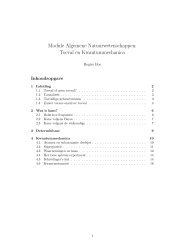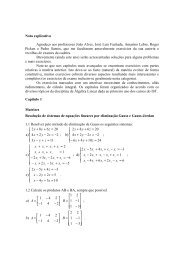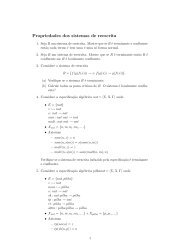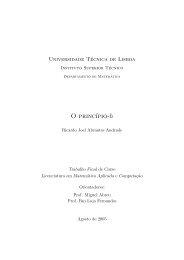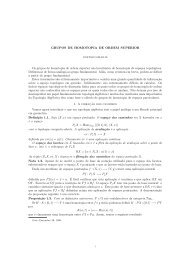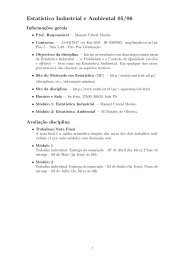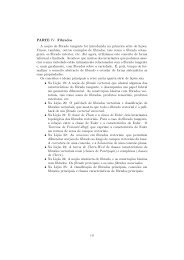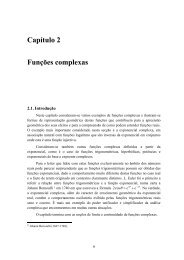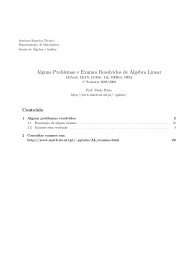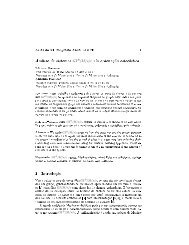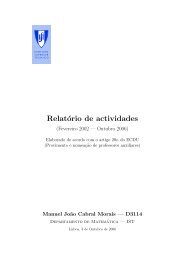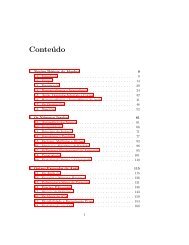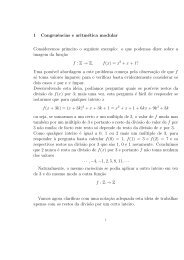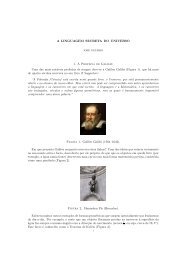Exercícios de Cálculo Integral e Diferencial I
Exercícios de Cálculo Integral e Diferencial I
Exercícios de Cálculo Integral e Diferencial I
Create successful ePaper yourself
Turn your PDF publications into a flip-book with our unique Google optimized e-Paper software.
iv) Pela alínea (ii), F é estritamente <strong>de</strong>crescente em ]0, +∞[ logo é injectiva nesse<br />
intervalo e, portanto, F restrita a esse intervalo é invertível. Pelo teorema da<br />
<strong>de</strong>rivada da função inversa tem-se, sendo G a inversa <strong>de</strong>ssa restrição,<br />
G ′ (F (1)) =<br />
1<br />
F ′ (G(F (1)))<br />
= 1<br />
F ′ (1)<br />
= 1<br />
− 1<br />
4<br />
= −4<br />
v) Pela alínea (i), F é contínua em [1, 3] e diferenciável em ]1, 3[ pois é diferenciável<br />
em R + . Então pelo teorema <strong>de</strong> Lagrange existe um c ∈]1, 3[ tal<br />
que<br />
F ′ (c) =<br />
F (3) − F (1)<br />
3 − 1<br />
=<br />
<br />
1<br />
1<br />
arctg − arctg<br />
3 1<br />
2<br />
= π/6 − π/4<br />
2<br />
= − π<br />
24<br />
Seja f : R → R uma função diferenciável em R. Suponha que f é par e que existe,<br />
emR, o limite limx→+∞ f(x) = L.<br />
i) Mostre que f é limitada em R.<br />
ii) Supondo adicionalmente que a função satisfaz<br />
Resolução.<br />
f(n + 1) = f(n)<br />
, ∀n∈N<br />
2n mostre que, necessariamente, se tem que verificar L = 0.<br />
i) Como f é diferenciável em R é contínua em R e, portanto, limitada em qualquer<br />
intervalo limitado. Por outro lado, como f(+∞) = L, qualquer que seja<br />
δ > 0 existe ɛ > 0 tal que f(x) ∈]L − δ, L + δ[ para x > 1.<br />
Por simetria, visto<br />
ɛ<br />
que f é par, f(x) ∈]L − δ, L + δ[ para x < − 1.<br />
Então f é limitada em R.<br />
ɛ<br />
ii) Como existe f(+∞) = L, pela <strong>de</strong>finição <strong>de</strong> limite segundo Heine, existem<br />
e têm o mesmo valor os limites das sucessões f(n + 1) e f(n). Aplicando<br />
limites a ambos os membros da igualda<strong>de</strong>, visto que tratarem <strong>de</strong> sucessões<br />
convergentes e 1<br />
2 n → 0, tem-se<br />
lim f(n + 1) = lim f(n)<br />
⇔ L = 0<br />
2n 19




